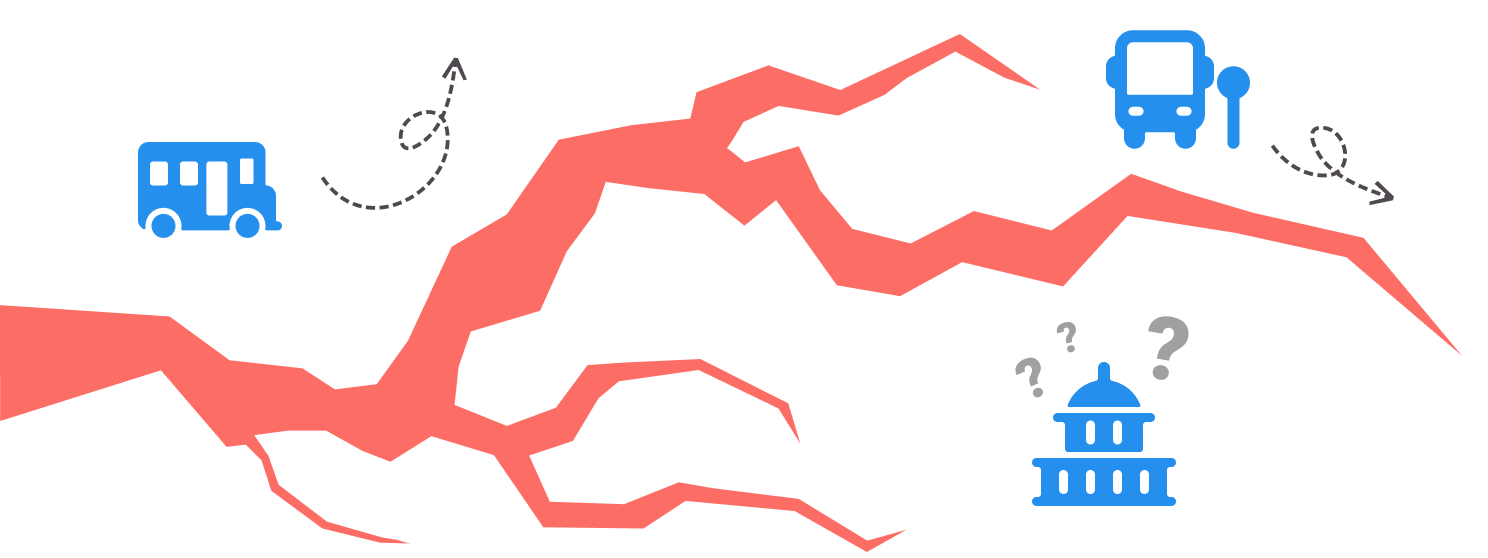The Problem of Fragmented Systems
Framing the Core Challenges
Over the past twenty years, school systems have been moving from a “one-size-fits-all” approach to a more learner-centric model; however, innovation in school transportation has not kept pace. Current K-12 transportation options are limited to a fixed set of high-cost transportation vendors and modes that are inflexible and burdensome to schools and families. Incentives are misaligned between school systems and transportation providers.
As a result, even where policy supports unbundling, school choice, and personalization, transportation is a major barrier for students and families to access high-quality learning opportunities. Never before has the need been greater to reimagine student transportation as an equitable and adaptable ecosystem of options that meet the needs of every student and family.
Key to reimagining student mobility is addressing fragmented systems caused by siloed organizations, disconnected interventions, geography, and economic barriers.

Siloed Organizations Create a Lack Transparency
Improving student mobility is often thwarted by an unwillingness to break down barriers between organizations or between organizations and government. For example, because efficiency improves at scale, charter schools might have some incentive to collaborate together or build relationships with districts to share assets, align bell times, and stack routes. This rarely happens, however, because schools are reluctant to make sacrifices for the sake of a collaboration that might challenge their own enrollment, require additional coordination and upfront effort, or require stakeholder adjustments.
More generally, even districts that are open and looking to collaborate (and states or regional entities more generally) typically have no visibility into the transportation networks or available capacity at other districts and so they cannot identify collaborative opportunities or find solutions for students that might cross borders. Similarly, city transit agencies rarely consider school demand in their own regional planning, and even where students could use transit, those districts don’t have ways to assess how well transit routes and schedules can meet their student demand.
However, while cross-entity collaboration and connectivity is rare, there are examples of innovative partnerships. Boston is a notable exception where city transit agencies and districts considered travel demand for older students in their regional plan and where the district engaged in thoughtful analysis in partnership with the MBTA to understand where student shifts to riding transit was plausible and safe (1). Rhode Island’s Department of Education (RIDE) offers an innovative state-level model where the state manages the hardest-to-serve needs that cut across regions and districts centrally. RIDE and 4MATIV also partnered in SY2021-2022 on an analysis of more flexible use of district-level capacity to meet regional needs on RIDE’s behalf.
And finally, North Carolina’s Transportation Information Management System (TIMS) shows how statewide sharing of routing info can support optimization, multi-school and multi-tier routing simulations, and integration with the state’s centralized student database (2, 3, 4).

Disconnected Interventions Create Redundancies
Fragmentation at all levels of student mobility continues to make improvements difficult. This is true even as innovation emerges in different sectors. For example, transit and school bus networks for high school students in major cities are typified by enormous overlap. Because most high schools enroll citywide, agencies aren’t aware of high school travel demand, and so districts and charters travel patterns criss-cross one another extensively. Indeed, districts and charter schools often lack the tools and inclination to investigate the feasibility and potential benefits of students using transit or a shared cross-district model (5). Similarly, when schools transporting students with special needs and students experiencing homelessness do so across district and regional boundaries, they send vehicles to and from the same neighborhoods at great expense.
At the state level, advocacy efforts have achieved successes in tackling the maze of regulations, but unfortunately, it is not evident whether these new funding and policy schemes are translating to shared learning or to the promulgation of best practices nationwide. For instance, advocates in Indiana, including The Mindtrust, won the increased flexibility to utilize smaller vehicles in their state, and in Arizona, parent payment programs have expanded at the same time as the amount and flexibility of K-12 scholarships have increased. But these kinds of initiatives have been uncoordinated at the national level and have not spurred similar changes in other states.

Geography Shapes School Choice
Even as school choice expands, distance remains a critical force shaping who goes to (and who teaches at) which school. Instead of evaluating a school based on its educational opportunities, proximity to home remains one of the most important factors in a family’s school decision. Indeed, long distances and commute times are strong deterrents for families to select a school, likely because they understand that longer school commutes are inversely related to sleep and exercise for teenagers (6). Long commutes coupled with early start times especially hurt teenagers, leading to reduced academic performance and negative health outcomes (7).
Indeed, distance is so important that some families relocate to be closer to the school of their choice. This is particularly challenging for rural schools. An EdChoice survey work found that parents in rural and small town communities were more likely than suburban and urban parents to say they have moved to be closer to a child’s school (8).
There are sharp racial disparities in the geography of learning opportunities. Marginalized neighborhoods often have limited preschool options and these families disproportionately feel their neighborhood school options are inadequate. Additionally, of state-funded preschool programs, only 40 percent meet preschool quality standards (9). Such inequities in access to quality preschool produce racial disparities in preschool enrollment, such as the six-percent gap in preschool enrollment between Black and White California children between the ages of three to five. During the COVID-19 transition to remote learning, affluent districts were two times as likely to offer live instruction than lower income districts (10).
Given the current variation in geographic proximity to quality learning options, transportation can be a key enabler for ensuring equitable access for all students regardless of where they reside. Transportation systems that include low-marginal cost mobility solutions for covering longer distances help expand student access to quality education options. However, greater distances do translate to higher transaction and monetary costs. Collaborations and co-routing across school systems that transport students farther distances are a key way to tackle fragmented operations and create real choice and equitable access across broad geographies in a manner that is operationally and financially sustainable.
